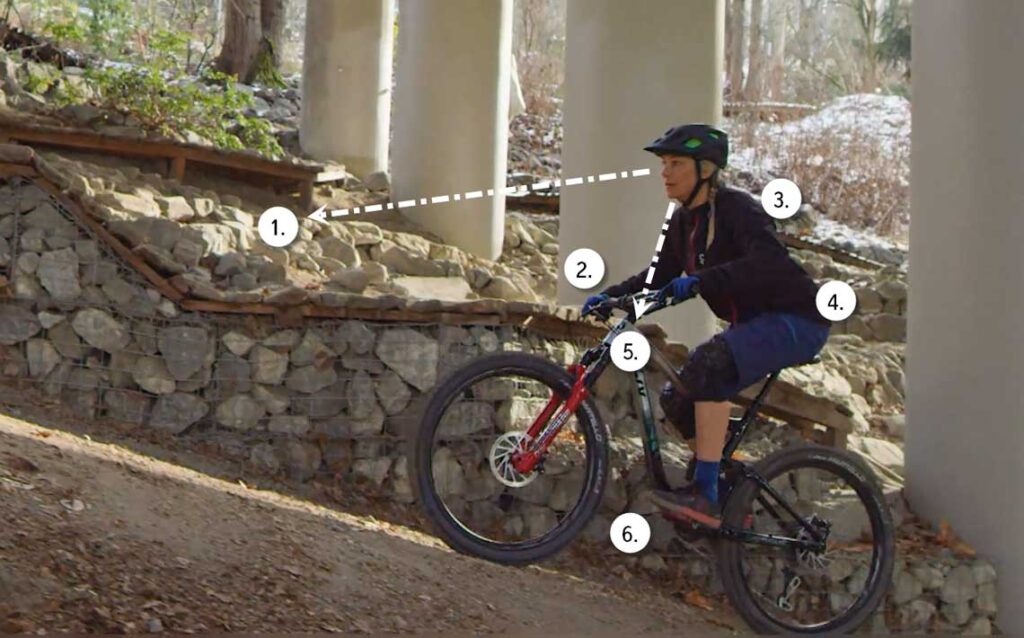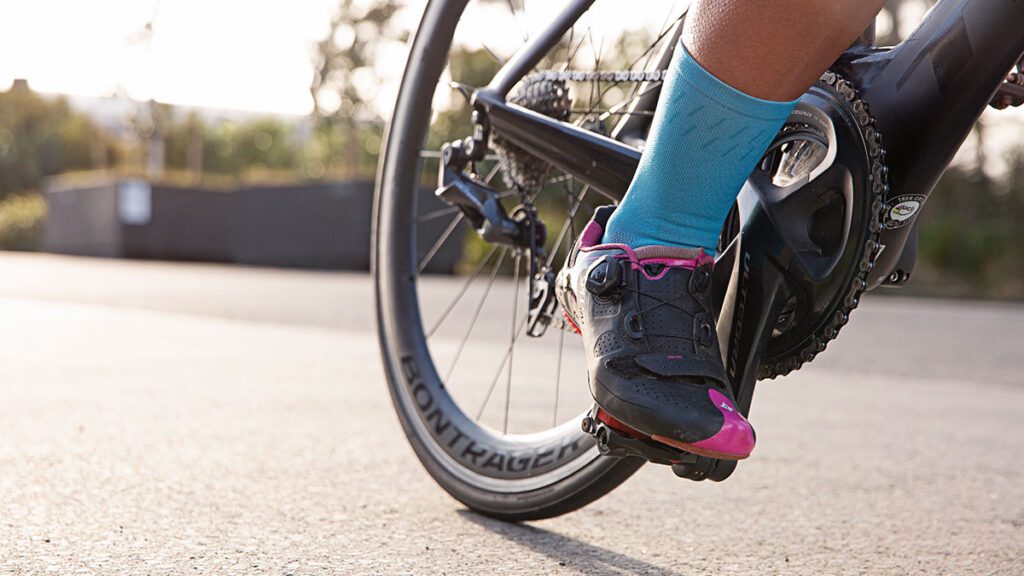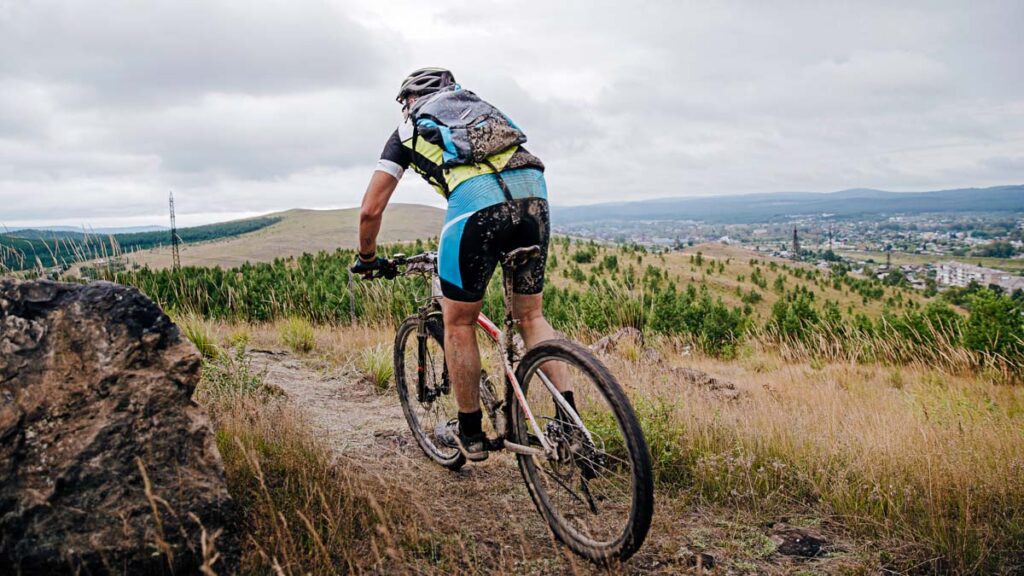


If you’re new to mountain biking, you will have a significant concern about “How To Ride Uphill On A Mountain Bike”. Riding uphill on a mountain bike can be tough, but it’s super cool once you get the hang of it.
In this guide, we’ll share easy tips to help you pedal up hills like a pro. To ride uphill on a mountain bike, shift to an easy gear, stay seated for traction, and maintain a steady pace. Keep your weight centered, focus on a clear path, and take breaks if needed.
Whether you’re just starting or want to get better, let’s dive into the basics of climbing on a mountain bike. Ready to take your biking to new heights?
Sit Tight for Balance



Here’s a straightforward guide on maintaining balance by staying seated while riding uphill on a mountain bike:
Seat Position:
Adjust your seat to a height where your legs have a slight bend at the bottom of the pedal stroke.
Stay Seated on Climbs:
When going up hills, keep seated to stay steady and in control.
Distribute Your Weight:
Keep your weight centered over the bike, distributing it evenly between the front and rear wheels.
Avoid Leaning Too Far:
Resist the urge to lean too far forward or backward. A balanced position helps your tires grip the trail.
Use Your Core:
Engage your core muscles to stabilize your upper body. This adds an extra layer of control.
Relax Your Grip:
Hold the handlebars firmly but avoid a death grip. Relaxing your hands and arms helps absorb bumps.
Look Ahead:
Keep your eyes on the trail ahead, not just your front wheel. This helps you see what’s coming and respond to changes in the terrain.
Practice on Varied Terrain:
Ride on different uphill surfaces to get accustomed to maintaining balance in various conditions.
Stay seated and centered on your bike to improve balance and make uphill climbs easier and more enjoyable. Happy riding!
Read More : ” How To Become A Better Mountain Biker? “
Get the Right Gear



Here’s a simple guide on getting the right gear for riding uphill on a mountain bike:
Understand Your Gears:
Know your bike’s gear system. Lower gears make it easier to climb. Don’t use harder gears.
Start in a Low Gear:
Begin the uphill climb in a low gear to make pedaling more manageable.
Shift Gradually:
As you climb, shift gears gradually to match the terrain. Anticipate changes in slope.
Avoid Cross-Chaining:
Don’t use extreme gears. Keep the chain in a straight line to prevent wear and improve efficiency.
Listen to Your Bike:
If pedaling feels too hard or too easy, adjust the gears until it feels right.
Experiment on Different Terrains:
Practice shifting gears on various uphill surfaces to get comfortable with different challenges.
Regular Maintenance:
Keep your bike in good condition. Lubricate the chain and ensure the gears shift smoothly.
Know When to Stand:
In steeper sections, standing on the pedals can provide extra power. Experiment to find what works for you.
Remember, finding the right gear is like finding the right rhythm for your climb. Take time to understand your bike, and soon you’ll conquer those uphill trails effortlessly!
Read More : ” Why Is Mountain Biking So Popular? “
Keep a Steady Pace



Here’s a straightforward guide on keeping a steady pace while riding uphill on a mountain bike:
Find Your Comfortable Pace:
Start at a pace that feels comfortable for you. It’s not a race—steady progress is key.
Use a Consistent Pedal Stroke:
Maintain a smooth and consistent pedal stroke. Avoid jerky movements to keep your momentum.
Breathe Regularly:
Focus on steady breathing. Inhale and exhale rhythmically to sustain energy and avoid fatigue.
Monitor Your Heart Rate:
Pay attention to your heart rate. Aim for a sustainable effort level to avoid burnout.
Adapt to the Terrain:
Adjust your pace based on the terrain. Speed up on flatter sections and ease off on steeper inclines.
Stay Relaxed:
Relax your body and grip on the handlebars. Stress can impact how well you keep a consistent speed.
Consider a Lower Gear:
If the climb becomes challenging, shift to a lower gear and maintain a higher cadence for efficiency.
Practice Pacing on Different Trails:
Ride on various uphill trails to practice adapting your pace to different conditions.
Remember, the key is to find a pace that allows you to make consistent progress without burning out. With practice, you’ll become adept at maintaining a steady rhythm on any uphill adventure. Happy riding!
Read More: how to ride over rocks on a mountain bike
Stay in the Middle



Here’s a simple guide on staying in the middle while riding uphill on a mountain bike:
Center Yourself:
Position your body in the middle of the bike. This helps distribute weight evenly for better balance.
Balance Over the Wheels:
Keep your weight centered over both wheels. This minimizes the risk of the front wheel lifting on steep climbs.
Avoid Leaning Too Far Forward:
Resist the urge to lean too far forward, as this can make it difficult to steer and maintain control.
Don’t Sit Too Far Back:
Similarly, avoid sitting too far back. This can reduce traction on the front wheel, making it harder to steer.
Engage Your Core Muscles:
Use your core muscles to stabilize your body. This adds an extra layer of control while keeping you centered.
Adapt to the Terrain:
Adjust your position based on the terrain. On steep sections, slightly shift your weight forward; on flatter stretches, stay centered.
Eyes on the Trail:
Keep your eyes focused on the trail ahead. This helps you anticipate changes in terrain and adjust your position accordingly.
Practice on Different Surfaces:
Ride on various uphill surfaces to practice staying centered in different conditions. This builds confidence and skill.
Stay centered and keep a balanced position to boost your control and flexibility when going uphill. Enjoy the journey!
Use Your Suspension Properly



Here’s a simple guide on using your suspension while riding uphill on a mountain bike:
Understand Your Suspension:
Know your bike’s suspension system. Most mountain bikes have front suspension (fork) and some also have rear suspension.
Adjust Suspension Settings:
Set your suspension according to the terrain. On uphill rides, think about making it firmer to save energy.
Front Suspension:
Use the front suspension to absorb bumps and uneven terrain. It helps maintain traction and keeps the front wheel in contact with the ground.
Rear Suspension (If Applicable):
If your bike has rear suspension, it helps absorb impacts, make you more comfortable, and improve control on uphill sections.
Lockout Feature:
Some bikes have a lockout feature. Use it on flat uphill parts to pedal more efficiently by reducing how much the suspension moves.
Experiment on Different Trails:
Practice using your suspension on various uphill trails to understand how it responds to different terrains.
Efficiency vs. Comfort:
Find the sweet spot between a firm suspension for efficiency and a comfy ride. Experiment to find the setting that suits your riding style.
Regular Maintenance:
Keep your suspension in good condition through regular maintenance. Lubricate moving parts and check for any issues before tackling challenging climbs.
Body Positioning:
Adjust your body position to work with the suspension. Stay centered and let the bike’s suspension handle the terrain.
Practice Riding Techniques:
Use the right riding tricks, like lifting your front wheel over obstacles, to go smoothly with your bike’s suspension.
By using your bike’s suspension properly, you can improve your uphill ride, making it smoother and more fun. Happy trails!
Final verdict (How To Ride Uphill On A Mountain Bike)
In conclusion, riding uphill on a mountain bike is all about finding the right balance and using your bike’s features wisely. To ensure your safety, remember to wear the appropriate gear.
Additionally, it is important to sit down while riding for better stability. Maintain a consistent speed throughout your ride. Stay in the middle position to maintain balance.
Lastly, make sure to utilize your suspension effectively.
With practice and mindfulness, conquering uphill trails will be a rewarding part of your mountain biking journey. So, gear up, enjoy the ride, and embrace the uphill challenges! Happy biking!
FAQs:
How do you climb uphill on a mountain bike?
To climb uphill on a mountain bike, maintain a steady cadence, shift to an easier gear, engage core muscles, lean slightly forward, and distribute weight evenly between arms and legs.
Which gear for cycling uphill?
When cycling uphill, it is recommended to shift to a lower gear to make pedaling easier. This allows for a higher cadence and better power output while conserving energy.
How do you bike uphill without getting tired?
To bike uphill without getting tired, maintain a steady pace, use proper breathing techniques, distribute weight evenly, engage core muscles, and gradually build your endurance through consistent training and conditioning.
What bike speed is best for uphill?
The best bike speed for uphill climbs depends on various factors such as gradient, terrain, and personal fitness level. Generally, maintaining a steady pace that allows for a sustainable effort is recommended.
Why low gear uphill?
Using a low gear uphill allows for easier pedaling by reducing the resistance. This enables the rider to maintain a higher cadence, conserve energy, and generate power more efficiently while climbing.



Welcome to Bikegenics, where passion meets performance! We are a leading online destination for all things related to mountain biking, dedicated to providing you with top-notch gear, expert advice, and an immersive community to fuel your two-wheeled adventures. With a commitment to excellence and a deep love for the sport, we strive to elevate your biking experience to new heights.
